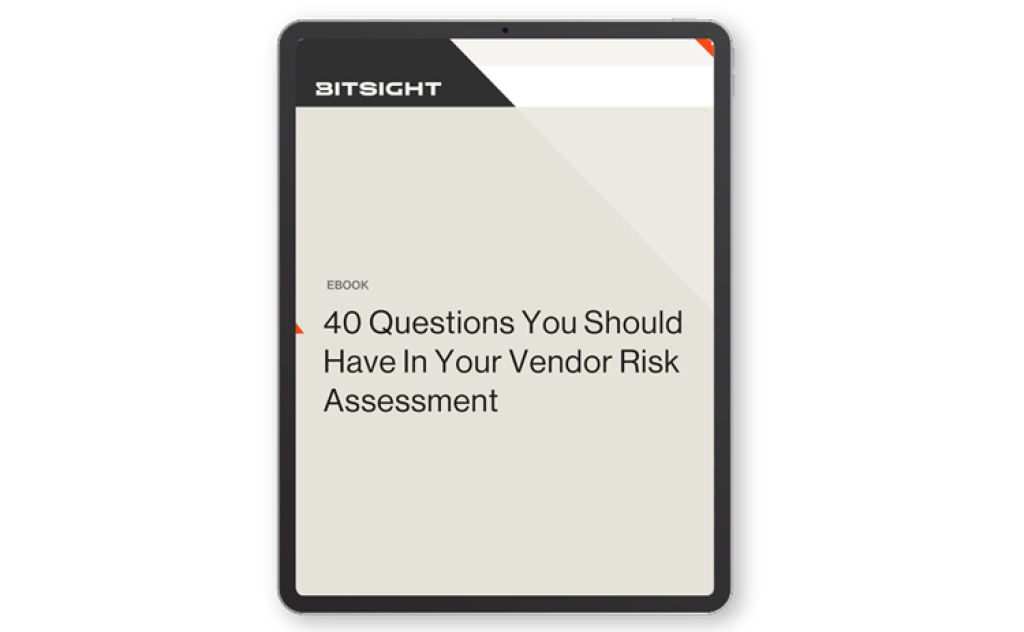With this ebook, we'll help you prioritize which vendors need the most attention with an in-depth security assessment – such as those with low security ratings, or critical vendors that maintain constant contact with your company’s systems.
Cyber Risk Management Framework
Developing A Cyber Risk Management Framework For Vendors
Third-party vendors are an essential part of business today. Offering products and services that help to make organizations more competitive, many vendors have become integral to the operations of businesses large and small. In fact, a recent study finds that 60% of organizations work with more than 1,000 third-party vendors – and that number is only expected to get larger.
While third parties deliver great value, they also represent significant risk. Vendors, partners, and contractors typically have significant access to an organization’s systems and sensitive data. As cyber security threats continue to evolve, this interconnectedness creates cyber security and risk management challenges for any organization using third-party vendors.
A robust cyber risk management framework for vendors is the key to superior third-party cyber risk management. When developing a cyber security risk management process and framework, many organizations today rely on technology from Bitsight to better manage their growing third party ecosystem.
What Is A Vendor Cyber Risk Management Framework?
A cyber risk management framework for vendors outlines the processes and procedures that an organization should follow to mitigate third-party risk. A well-developed vendor cyber risk management framework provides a foundation that integrates cyber security risk management into the entire vendor lifecycle. With a framework guiding all decisions around vendor selection, onboarding, and assessment, you can gain insight into areas of highest risk and make more informed decisions to mitigate it.
Essential tasks in a vendor cyber risk management framework should include:
- Setting policies for procurement. When evaluating a large pool of vendors, a standard set of requirements will help to ensure that the vendors you select meet your security requirements. A security ratings service can be an invaluable first line of defense here, providing a consistent requirement that lets your team minimize time spent analyzing vendors that don’t meet your security standards.
- Communicating policies across business units. Ensuring that policies are clearly understood by leaders and managers of each area of the business can help to streamline vendor selection and assessment. For example, setting a minimum security rating for all vendors can help align departments and allow business units to prescreen their list of potential vendors prior to performing an in-depth assessment and requesting time from other departments.
- Establishing policies for assessment. Implementing the right policies during the assessment phases of your third-party risk management program can help to streamline efforts as you scale your program to accommodate a larger number of vendors. For example, a policy that requires a reassessment when any adverse cyber event occurs within a specific vendor tier can help to improve risk management and provide transparency about expectations for everyone involved in a vendor relationship.
- Establishing tiers of risk. To run a more efficient vendor risk management program, your cyber risk management framework may establish tiers of vendors based on the risk they represent to your organization. Vendors who work closely with secure data and processes may belong to a higher or more critical tier, while vendors representing less risk fall to a lower tier. Vendors in higher tiers can be monitored more closely and their assessments may require more detail.
- Continuously monitoring security status. Rather than conducting an annual assessment of a vendor’s security posture, you can continuously monitor the security performance of vendors to receive immediate notification when their security posture changes or dangerous activity occurs. This allows you to combat risks as soon as they arise, but also save time and resources on vendors that don’t really need assessing.
- Communicating third-party risk to stakeholders. Your vendor cyber risk management framework and the data it produces must be successfully communicated to your executive leadership and board to demonstrate success and justify budgets. Your framework must provide a common set of metrics and essential context so that that individuals without security expertise will have a sense of the risks confronting the organization and the controls and programs in place to mitigate it.
Bitsight For Third-Party Risk Management
When developing your cyber risk management framework for vendors, Bitsight for Third-Party Risk Management offers a wealth of tools, resources, and capabilities for reducing cyber risk.
Bitsight for Third-Party Risk Management provides automated tools for continuous cyber risk monitoring of vendors’ security posture, enabling you to immediately expose cyber risk within your supply chain so you can effectively focus resources to remediate it.
Bitsight’s industry-leading Security Ratings Service provides a daily assessment of a vendor’s security performance based on objective, externally verifiable data. Ratings are based on 120+ data points in categories that include compromised systems, user behavior, security diligence, and publicly disclosed data breaches. Ratings range from 250 to 900 – the higher the rating, the more effective the vendor is at maintaining good security practices. With daily Security Ratings from Bitsight, your security team can support your cyber risk management framework by proactively identifying, quantifying, and managing risk throughout your vendor ecosystem.
Developing A Cyber Risk Management Framework With Bitsight
Bitsight for Third-Party Risk Management and other Bitsight technologies provide all of the tools required to develop and support a third-party cyber risk management framework. With Bitsight, you can:
- Enable your business by bringing on vendors in a timely way. With Bitsight, you can help your organization enjoy the benefits of working with vendors while summarizing and communicating the risk that is associated with each relationship. Bitsight enables you to communicate technical details to stakeholders throughout the organization, using a common language and set of easily understood metrics that enable everyone to make outcomes-based, informed decisions.
- Onboard vendors faster. Smart tiering recommendations, workflow integration, and risk vector breakdowns that identify areas of known risk can help to accelerate onboarding and making your third-party risk management program more scalable.
- Mitigate third-party risk. Make confident, data-driven decisions to prioritize resources, improve operational efficiency, and drive efficient risk reduction across your vendor portfolio.
- Improve executive reporting. Bitsight facilitates data-driven conversations with senior executives and board members by streamlining the reporting process, demonstrating how investments in security directly impact performance, and providing essential metrics and context that enable oversight of your cyber security plan.
Why choose Bitsight?
An industry-leading solution
Bitsight is the world’s leading provider of cyber risk intelligence, transforming how security leaders manage and mitigate risk. Leveraging the most comprehensive external data and analytics, Bitsight empowers organizations to make confident, data-backed decisions and equips security and compliance teams from over 3,300 organizations across 70+ countries with the tools to proactively detect exposures and take immediate action to protect their enterprises and supply chains. Bitsight customers include 38% of Fortune 500 companies, 4 of the top 5 investment banks, and 180+ government agencies and quasi-governmental authorities, including U.S. and global financial regulators.
Extensive visibility
Bitsight operates one of the largest risk datasets in the world. Leveraging over 10 years of experience collecting, attributing, and assessing risk across millions of entities, we combine the power of AI with the curation of technical researchers to unlock an unparalleled view of your organization. Bitsight offers more complete visibility into important risk areas such as botnets, mobile apps, IoT systems, and more. Our cyber data collection and scanning capabilities include:
- 40 million+ monitored entities
- 540 billion+ cyber events in our data lake
- 4 billion+ routable IP addresses
- 500 million+ domains monitored
- 400 billion+ events ingested daily
- 12+ months of historical data
Superior analytics
Bitsight offers a full analytics suite that addresses the challenges of peer comparison, digital risk exposure, and future performance.
Ratings validation
Bitsight is the only rating solution with third-party validation of correlation to breach from AIR Worldwide and IHS Markit.
Quantifiable outcomes
Bitsight drives proven ROI with significant operational efficiency and risk reduction outcomes.
Prioritization of risk vectors
Bitsight incorporates the criticality of risk vectors in to calculation of Security Ratings, highlighting risk in a more diversified way to ensure the most critical assets and vulnerabilities are ranked higher.
FAQs: What Is A Third-Party Cyber Risk Management Framework?
Third-party cyber risk management is the task of assessing and mitigating risk in relationships with third-party vendors. Third-party cyber risk management typically involves assessing the security performance of each vendor against cybersecurity standards to determine which vendors to select, or to help existing vendors remediate their security issues.
A third-party cyber risk management framework articulates the processes and procedures to which organizations should adhere as they assess, monitor, and mitigate risk in their vendor ecosystem.
Bitsight Security Ratings are an objective measurement of an organization’s security performance. Bitsight Security Ratings are generated through the analysis of observable, verifiable data related to compromised systems, security diligence, user behavior, and data breaches. Calculated using a proprietary algorithm, Bitsight Security Ratings provide organizations with a daily assessment of their own security performance and the security posture of their vendors.


